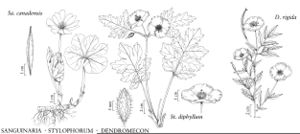familyPapaveraceae
genusSanguinaria
Show Lower Taxa
Sanguinaria
Sp. Pl. 1: 505. 175.
Gen. Pl. ed. 5, 223. 1754.
Common names: Bloodroot puccoon sanguinaire du Canada sang-dragon
Etymology: Latin sanguis, blood, in reference to color of sap
Treatment appears in FNA Volume 3.
| Taxon | Illustrator ⠉ | |
|---|---|---|
 | Sanguinaria canadensis Stylophorum diphyllum Dendromecon rigida | John Myers John Myers John Myers |
Herbs, perennial, scapose, from thick rhizomes; sap orange to red. Leaves 1, or few and rosulate, sheathing-petiolate; blade 1× palmately lobed. Inflorescences terminal, 1 (-3) -flowered; bracts absent. Flowers: sepals 2, distinct; petals 6-12, unequal; stamens many; pistil 2-carpellate; ovary 1-locular; style ± distinct; stigma 2-lobed. Capsules erect, 2-valved, dehiscing from base. Seeds few-to-many, arillate. x = 9.
Discussion
Species 1
Sanguinaria is similar, and probably most closely related, to Eomecon Hance of eastern Asia, which is monotypic also.
Selected References
None.
Lower Taxa
"thick" is not a number.
... more about "Sanguinaria"
perigynous +
lobed +
absent +
2-valved +
dehiscing +
erect +
North America +
capsular +
1(-3)-flowered +
sheathing-petiolate +
perigynous +
distinct +
absent +
obovate +
unequal +
2 times number of sepals +
2-carpellate +
parietal +
1754 +
expanded +
sticky +
arillate +
few;many +
1-seeded +
caducous +
distinct +
obovate +
many +
2;many +
2;many +
2-lobed +
distinct +
absent +
Sanguinaria +
Papaveraceae +
genus +
scapose +
perennial +
small +